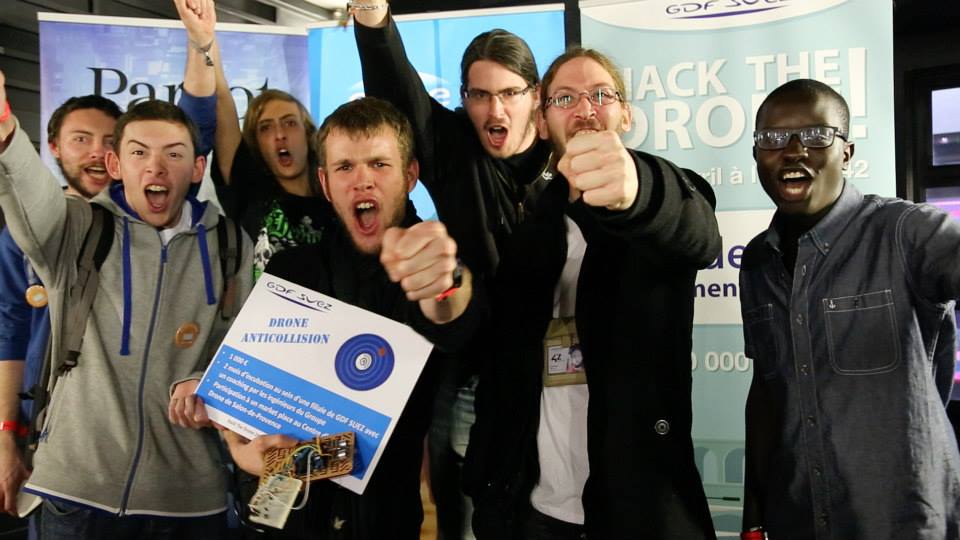
Composed mainly of students from the School 42, the DPM team created an efficient and low cost project that led to it being declared the winner of this challenge.
The DPM team
Stéphane, Benoît, Antoine and Babacar make up the core of the team. They are all students at the Ecole 42 from the classes of 2014 and 2013. Reinforcements brought in for the Hackathon include Yannick, Jean, Jerôme and Valentin.
From fields as diverse as law, aerospace and information technology, they ended up with the same passion for designing solutions, a passion typical of the School 42 as well as of hackathons in general.
They define themselves as a small team, and are really happy to have won and to have helped advance Engie’s project!
The Hack the Drone Hackathon
With an overall theme of "civilian uses for drones", Hack the Drone included four separate drone challenges: drone neutralization , drone anti collision experiments, drone metering and drone testing.
The DPM team chose to enter the Drone Anti Collision competition.
In the words of Stéphane Raccah, a hackathon is a major operation, with big problems to solve, but it's also fun!
"Hackathon always take place in very similar ways: you discover the hardware on which you will work, and you modify, adapt, and use it to solve the challenges put forward. Most of the hard work is in solving problems - and this is what makes it fun for us! "
The DPM Drone Anti Collision project
Like the other solutions designed during the collision challenge of the hackathon, the DPM team used sonar, which has the advantage of minimal cost.
The principle is to use several sonar devices on the drone, which allows it to "see" all around it. The sonar sends sound waves and analyzes their echo to determine how far away obstacles are.
The idea is to create a sonic bubble around the drone. If the obstacle is too close, the system takes control of the drone away from the driver to lead it away from the obstacle and put it back in a "safe" area.
If the same principle was broadly used by all the teams in the collision challenge, the DPM project analyzed a lot of data: for example, it was able to adapt to the speed of a moving obstacle to enlarge its security zone.
Post hackathon perspectives?
One of the awards for winning the hackathon of a 3-month incubation process for the project as defined at the hackathon. Now, the DPM team expects to develop an ambitious project called Flylab in partnership with Engie, the 42 School and MIT. Prior to joining the Flylab, which will give them substantial means for working together and accelerating their project’s development, the various team members are continuing to develop the project at home.
Note that shortly after the hackathon, a product using a very similar technology was launched in Asia. Coincidence or copy? Hard to say, but where the DPM project will be very inexpensive, the Chinese project is sold over $1,000...
What next? 5 team members are students at the School 42 at least another year or two and are not considering immediately creating a company to market their project.
Drones in service of humans
However, Stéphane Raccah says he wants to continue working in airplane modeling. He believes in the extraordinary possibilities of drones to help humans, and that's what interests him. As an example, he quoted us a project by two young women who developed a drone that cancelled out sandstorms, and he dreams of drones that monitor the coast to rescue people from drowning or putting out fires...
In Dubai, the "Drones for Good" competition is dedicated to the use of innovative technologies involving drones to improve the lives of men and women. With a budget of $1 billion in 2015, it awarded its top prize to another anti-collision project produced by a Swiss team.
Perhaps one day we can expect to see DPM finish first place in Dubai? This is certainly what we anticipate from this team of enthusiasts who said at the end of the interview: "The whole team is really happy to have gotten this far already!"
Sign up for the ENGIE Innovation Newsletter